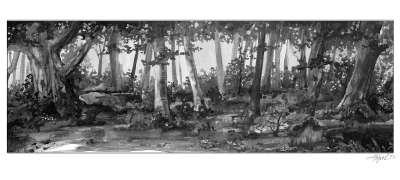
Decayed wood crumbled underfoot as I stepped on a mossy log. The ground was almost hidden by a lush, diverse growth of wildflowers and ferns. Brown scapes of wild leeks poked up above mottled leaflets of Virginia waterleaf and heart-shaped leaves of wild ginger. A green canopy of mostly sugar maple and yellow birch towered overhead. As we climbed higher on the mountainside, the trees increased in height and girth. We were in an old-growth forest, a remnant of the forest that blanketed the Northeast before European settlement. The extremely steep slope had likely allowed it to escape the axe and saw before it was protected.
In “Ecology and Recovery of Eastern Old-Growth Forests” (2018), forest ecologists Andrew Barton and William Keeton define old-growth as “forests with old trees that have been largely undisturbed by people since their origins.” Many ecologists add that the dominant trees must have attained over 50 percent of the maximum lifespan for that species. Old-growth does not always equal big trees, however; stunted, high-elevation spruce-fir forests and ancient cliffside cedars also qualify.
In the old-growth forest my husband and I visited, the larger yellow birches were big – 2 1/2 to 4 feet in diameter – with scaly bark not at all like the smooth, shiny bark of younger yellow birch. These trees may have been 200 to 300 years old and had survived brutal winters, major storms, and droughts. Many species of lichens, mosses, and fungi found homes on their bark. The birches grew on mounds: the remains of rootballs from fallen trees. On the uphill side of each mound was a depression where the previous tree once stood. This pit-and-mound topography is characteristic of old-growth forests.
Snags – standing dead trees – were scattered about, some with fresh excavations from a pileated woodpecker. An ovenbird called “teacher, teacher, teacher,” and the downward spiraling song of the veery echoed through the woods. The hordes of biting insects that attacked us undoubtedly provide abundant food for these and many other birds. A huge tree had recently fallen, leaving a sunlit gap in the canopy. Young trees will sprout in this clearing, contributing to the variety of age classes typical of an old forest.
Studies indicate that old-growth forests differ significantly from the second and third-growth woodlands that make up most of the forests in the Northeast. Younger woodlands have different proportions of species, different habitats, and altered ecological processes. Old forests have more dead wood in all sizes and stages of decay, which increases the diversity and abundance of fungi, mosses, insects, salamanders, and some birds and mammals, and is important to nutrient cycling. These forests often have more wildflowers and other herbaceous vegetation than previously-logged stands. The structural complexity of old forests, with trees of different ages and heights, multi-layered canopies, and diverse bark textures, creates more habitats, and these undisturbed woodlands tend to stay warmer in winter and cooler and moister in summer.
Old-growth has ecological, scientific, educational, aesthetic, and spiritual value. These biodiverse forests “provide a storehouse of genetic diversity that has evolved over eons and…a unique research laboratory for scientists, allowing them to investigate the workings of nature with relatively few confounding human impacts,” writes Andrew Barton. Old-growth forests also typically store more carbon than younger woodlands (although they don’t pull in as much carbon from the atmosphere), a benefit in the fight against climate change.
After the arrival of European settlers, the vast majority of northeastern forests were harvested for timber or cleared for agriculture. But pockets of old-growth, and even a few large tracts, survived on lands put into public ownership in the 1800s and early 1900s, on estates, and in inaccessible places. The Adirondack Park includes roughly 200,000 acres of old-growth forest, much more than other northeastern states. Less than 1 percent of the forested land in Vermont and New Hampshire is old-growth. But forests that have been set aside as wilderness areas and nature preserves will eventually develop old-growth characteristics. And some foresters and loggers are changing cutting practices to leave ecologically valuable attributes, such as snags and big trees, in forests that are also managed for timber.
A few easy-to-access old-growth forests you can visit are New Hampshire’s Snyder Brook Scenic Area in the White Mountain National Forest, the Old Forest in Franconia Notch State Park, and Vermont’s Gifford Woods State Park.


Discussion *